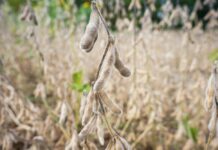WASHINGTON – The heat and humidity are no bother to Ricardo Goenaga as he walks from tree to 9-foot-tall tree in an experimental plot the USDA Agricultural Research Service maintains in Isabela, on Puerto Rico’s northwest coast.
The plant physiologist picks a red, spiky, Ping-Pong-ball-sized fruit from one tree and uses his thumbs to peel it open and reveal bright, off-white flesh. He takes a bite.
“A bit bitter,” he says.
Goenaga samples another of the peculiar morsels on an adjacent tree.
“Not quite right.”
There’s success at the next stop. On taking a taste, Goenaga’s eyebrows rise, and he nods affirmatively.
“Yes, here,” he says. “This is some good rambutan.”
He’s right. The pulp inside this curious offering’s soft skin – the reddish fruit resembles one of those squeeze toys covered by long, rubbery spikes – has the sweet taste of a pear.
Rambutan (ram-bu-TAHN), Nephelium lappaceum, is among the more fascinating examples of exotic tropical fruit studied at the service’s Tropical Agriculture Research Station, a versatile and unique research laboratory based in Mayag
Get 4 Weeks of Farm and Dairy Home Delivered









